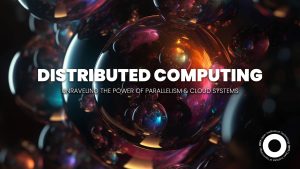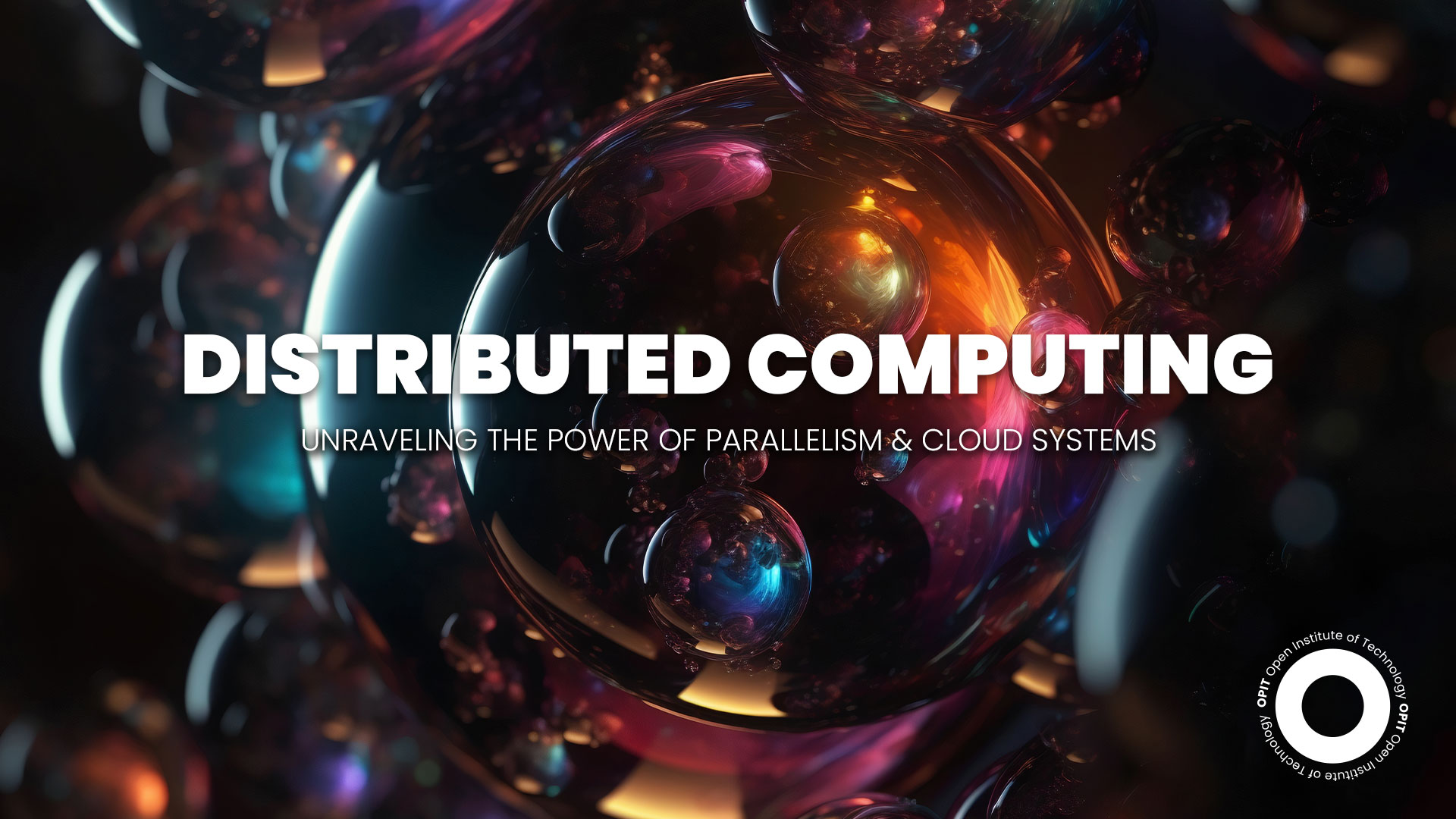

Did you know you’re participating in a distributed computing system simply by reading this article? That’s right, the massive network that is the internet is an example of distributed computing, as is every application that uses the world wide web.
Distributed computing involves getting multiple computing units to work together to solve a single problem or perform a single task. Distributing the workload across multiple interconnected units leads to the formation of a super-computer that has the resources to deal with virtually any challenge.
Without this approach, large-scale operations involving computers would be all but impossible. Sure, this has significant implications for scientific research and big data processing. But it also hits close to home for an average internet user. No distributed computing means no massively multiplayer online games, e-commerce websites, or social media networks.
With all this in mind, let’s look at this valuable system in more detail and discuss its advantages, disadvantages, and applications.
Basics of Distributed Computing
Distributed computing aims to make an entire computer network operate as a single unit. Read on to find out how this is possible.
Components of a Distributed System
A distributed system has three primary components: nodes, communication channels, and middleware.
Nodes
The entire premise of distributed computing is breaking down one giant task into several smaller subtasks. And who deals with these subtasks? The answer is nodes. Each node (independent computing unit within a network) gets a subtask.
Communication Channels
For nodes to work together, they must be able to communicate. That’s where communication channels come into play.
Middleware
Middleware is the middleman between the underlying infrastructure of a distributed computing system and its applications. Both sides benefit from it, as it facilitates their communication and coordination.
Types of Distributed Systems
Coordinating the essential components of a distributed computing system in different ways results in different distributed system types.
Client-Server Systems
A client-server system consists of two endpoints: clients and servers. Clients are there to make requests. Armed with all the necessary data, servers are the ones that respond to these requests.
The internet, as a whole, is a client-server system. If you’d like a more specific example, think of how streaming platforms (Netflix, Disney+, Max) operate.
Peer-to-Peer Systems
Peer-to-peer systems take a more democratic approach than their client-server counterparts: they allocate equal responsibilities to each unit in the network. So, no unit holds all the power and each unit can act as a server or a client.
Content sharing through clients like BitTorrent, file streaming through apps like Popcorn Time, and blockchain networks like Bitcoin are some well-known examples of peer-to-peer systems.
Grid Computing
Coordinate a grid of geographically distributed resources (computers, networks, servers, etc.) that work together to complete a common task, and you get grid computing.
Whether belonging to multiple organizations or far away from each other, nothing will stop these resources from acting as a uniform computing system.
Cloud Computing
In cloud computing, centralized data centers store data that organizations can access on demand. These centers might be centralized, but each has a different function. That’s where the distributed system in cloud computing comes into play.
Thanks to the role of distributed computing in cloud computing, there’s no limit to the number of resources that can be shared and accessed.
Key Concepts in Distributed Computing
For a distributed computing system to operate efficiently, it must have specific qualities.
Scalability
If workload growth is an option, scalability is a necessity. Amp up the demand in a distributed computing system, and it responds by adding more nodes and consuming more resources.
Fault Tolerance
In a distributed computing system, nodes must rely on each other to complete the task at hand. But what happens if there’s a faulty node? Will the entire system crash? Fortunately, it won’t, and it has fault tolerance to thank.
Instead of crashing, a distributed computing system responds to a faulty node by switching to its working copy and continuing to operate as if nothing happened.
Consistency
A distributed computing system will go through many ups and downs. But through them all, it must uphold consistency across all nodes. Without consistency, a unified and up-to-date system is simply not possible.
Concurrency
Concurrency refers to the ability of a distributed computing system to execute numerous processes simultaneously.
Parallel computing and distributed computing have this quality in common, leading many to mix up these two models. But there’s a key difference between parallel and distributed computing in this regard. With the former, multiple processors or cores of a single computing unit perform the simultaneous processes. As for distributed computing, it relies on interconnected nodes that only act as a single unit for the same task.
Despite their differences, both parallel and distributed computing systems have a common enemy to concurrency: deadlocks (blocking of two or more processes). When a deadlock occurs, concurrency goes out of the window.
Advantages of Distributed Computing
There are numerous reasons why using distributed computing is a good idea:
- Improved performance. Access to multiple resources means performing at peak capacity, regardless of the workload.
- Resource sharing. Sharing resources between several workstations is your one-way ticket to efficiently completing computation tasks.
- Increased reliability and availability. Unlike single-system computing, distributed computing has no single point of failure. This means welcoming reliability, consistency, and availability and bidding farewell to hardware vulnerabilities and software failures.
- Scalability and flexibility. When it comes to distributed computing, there’s no such thing as too much workload. The system will simply add new nodes and carry on. No centralized system can match this level of scalability and flexibility.
- Cost-effectiveness. Delegating a task to several lower-end computing units is much more cost-effective than purchasing a single high-end unit.
Challenges in Distributed Computing
Although this offers numerous advantages, it’s not always smooth sailing with distributed systems. All involved parties are still trying to address the following challenges:
- Network latency and bandwidth limitations. Not all distributed systems can handle a massive amount of data on time. Even the slightest delay (latency) can affect the system’s overall performance. The same goes for bandwidth limitations (the amount of data that can be transmitted simultaneously).
- Security and privacy concerns. While sharing resources has numerous benefits, it also has a significant flaw: data security. If a system as open as a distributed computing system doesn’t prioritize security and privacy, it will be plagued by data breaches and similar cybersecurity threats.
- Data consistency and synchronization. A distributed computing system derives all its power from its numerous nodes. But coordinating all these nodes (various hardware, software, and network configurations) is no easy task. That’s why issues with data consistency and synchronization (concurrency) come as no surprise.
- System complexity and management. The bigger the distributed computing system, the more challenging it gets to manage it efficiently. It calls for more knowledge, skills, and money.
- Interoperability and standardization. Due to the heterogeneous nature of a distributed computing system, maintaining interoperability and standardization between the nodes is challenging, to say the least.
Applications of Distributed Computing
Nowadays, distributed computing is everywhere. Take a look at some of its most common applications, and you’ll know exactly what we mean:
- Scientific research and simulations. Distributed computing systems model and simulate complex scientific data in fields like healthcare and life sciences. (For example, accelerating patient diagnosis with the help of a large volume of complex images (CT scans, X-rays, and MRIs).
- Big data processing and analytics. Big data sets call for ample storage, memory, and computational power. And that’s precisely what distributed computing brings to the table.
- Content delivery networks. Delivering content on a global scale (social media, websites, e-commerce stores, etc.) is only possible with distributed computing.
- Online gaming and virtual environments. Are you fond of massively multiplayer online games (MMOs) and virtual reality (VR) avatars? Well, you have distributed computing to thank for them.
- Internet of Things (IoT) and smart devices. At its very core, IoT is a distributed system. It relies on a mixture of physical access points and internet services to transform any devices into smart devices that can communicate with each other.
Future Trends in Distributed Computing
Given the flexibility and usability of distributed computing, data scientists and programmers are constantly trying to advance this revolutionary technology. Check out some of the most promising trends in distributed computing:
- Edge computing and fog computing – Overcoming latency challenges
- Serverless computing and Function-as-a-Service (FaaS) – Providing only the necessary amount of service on demand
- Blockchain – Connecting computing resources of cryptocurrency miners worldwide
- Artificial intelligence and machine learning – Improving the speed and accuracy in training models and processing data
- Quantum computing and distributed systems – Scaling up quantum computers
Distributed Computing Is Paving the Way Forward
The ability to scale up computational processes opens up a world of possibilities for data scientists, programmers, and entrepreneurs worldwide. That’s why current challenges and obstacles to distributed computing aren’t particularly worrisome. With a little more research, the trustworthiness of distributed systems won’t be questioned anymore.
Related posts

Source:
- IE University – Insights, Published on October 15th, 2024.
By Francesco Derchi
Purpose is a strategic tool for driving innovation, competitive advantage, and addressing AI challenges, writes Francesco Derchi.
Since the early 2000s, technology has dominated discussions among scholars and professionals about global development and economic trends, with the first wave of research regarding the internet’s impact on firms and society focusing on the enabling potential of technologies. The concept of “digital revolution,” as popularized by Nicholas Negroponte, became the new paradigm for broader considerations about the development of the firm’s macro environment, and how businesses could leverage it as an asset for creating competitive advantage. The following wave focused on the convergence of different technologies, such as manufacturing, and included the dynamics of coexistence between humans and machines. From the management side, the major challenges are related to defining effective digital transformation practices that could help to migrate organizations and exploit this new paradigm.
The current technological focus builds on these previous trends, particularly on artificial intelligence and more recently on the emergence of generative AI. The Age of AI is characterized by technology’s power to reshape business and society on a variety of levels. While AI’s pervasive impact is not new for firms, the mainstream adoption of ChatGPT for business purposes and the response to this ready adoption from big tech players like Microsoft, Google, and more recently Apple, shows how AI is reshaping and influencing companies’ strategic priorities.
From a research perspective, AI’s societal impact is inspiring new studies in the field of ethics. Luciano Floridi, now of Yale University, has identified several challenges for AI, characterizing them by global magnitudes like its environmental impact and has identified several challenges for AI security, including intellectual property, privacy, transparency, and accountability. In his work, Floridi underlines the importance of philosophy in defining problems and designing solutions – but it is equally important to consider how these challenges can be addressed at the firm level. What are the tools for managers?
Part of the answer may lie in the increasing and recent focus of management studies around “corporate purpose” and “brand purpose.” This trend represents an important attempt to deepen our understanding of “why to act” (purpose framing) and “how to act” (purpose formalizing and internalizing), while technology management studies address the “what to act” (purpose impacting) question. Furthermore, studies show that corporate purpose is critical for both digital native firms as well as traditional companies undergoing a digital transformation, serving as an important growth engine through purpose-driven innovation. It is therefore fair to ask: can purpose help in addressing any of the AI challenges previously mentioned?
Purpose concepts are not exclusively “cause-related” like CSR and environmental impact. Other types have emerged, such as “competence” (the function of the product) and “culture” (the intent that drives the business). This broadens the consideration of impact types that can help address specific challenges in the age of AI.
Purpose-driven organizations are not new. Take Tesla’s direction “to accelerate the world’s transition to sustainable energy” – it explicitly addresses environmental challenges while defining a business direction that requires constant innovation and leverages multiple converging technologies. The key is to have the purpose formalized and internalized within the company as a concrete drive for growth.
Due to its characteristics, the MTP plays a key role in digital transformation. This necessarily ambitious and long-term vision or goal – the Massive Transformative Purpose – requires firms, particularly those focused on exponential growth, to address emerging accelerating technologies with a purpose-first transformation logic. P&G’s Global Business Services division was able to improve market leadership and gain a competitive advantage over various start-ups and potential disruptors through its “Free up the employee, for free” MTP. This served as a north star for every employee, encouraging them to contribute ideas and best practices to overcome bulky processes and limitations.
My research on MTPs in AI-era firms explores their role in driving innovation to address specific challenges. Results show that the MTP impacts the organization across four dimensions, requiring commitment and synergy from management. Let’s consider these four dimensions by looking at Airbnb:
- Internal Impact: The MTP acts as the organization’s genetic code and guiding philosophy. It is key for leveraging employee motivation, with a strong relationship between purpose, organizational culture, and firm values. Airbnb’s culture of belonging highlights this, with its various purpose-shaping practices, starting with culture-fit interviews delivered during the recruitment process.
- Brand and Market Influence: The MTP contributes directly to building a strong brand and influencing the market. It allows firms to extend beyond functional and symbolic benefits to make the impact of the company on society visible. This involves addressing market demand coherently and consistently. Airbnb’s “Bélo” symbol visually represents this concept of belonging while their MTP features in campaigns like “Wall and Chain: A Story of Breaking Down Walls.”
- Competitive Advantage and Growth: The MTP drives innovation and can lead to superior stock market performance. In digital firms, it’s key in the creation of ecosystems that aggregate leveraged assets and third parties for value creation. The company’s “belong anywhere transformation journey” is a strategic initiative that formalized and interiorized the MTP through various touchpoints for all the different ecosystem members. As Leigh Gallagher details in her 2016 Fortune feature about the company, “When travellers leave their homes, they feel alone. They reach their Airbnb, and they feel accepted and taken care of by their host. They then feel safe to be the same kind of person they are when they’re at home.”
- Core Organization Identity: The MTP is considered part of the core dimension of the organization. More than a goal or business strategy, it is a strategic issue that generates a sense of direction and purpose that affects every part of the organization: internal, external, personality, and expression. This dimension also involves the role of the founder(s) and their personality in shaping the business. At Airbnb, the MTP is often used as a shortcut to explain the firm’s mission and vision. The founders’ approach is pragmatic, and instead of debating differences, time should be spent on execution. At the same time, the personalities of the three founders, Chesky, Gebbia, and Blecharcyzk, are the identity of the firm. They were the first hosts for the platform. Their credibility is key for making Airbnb a trustworthy and coherent proposal in a crowded market.
Executives and leaders of business in the current AI era should embrace three key principles. Be true: Purpose is an essential strategic tool that enables firms to identify and connect with their original selves, decoding their reason for being and embedding it into their identity. Be ambitious: The MTP allows for global impact, confronting major challenges by synthesizing business values and guiding innovation paths to address AI-related issues. Be generous: Purpose allows firms to explicitly address environmental and social issues, taking action on values-based challenges such as transparency, respect for intellectual property, and accountability. By following these principles, organizations and their leaders can maintain their direction and continue to advance in the AI era.
Read the full article below:

Source:
- Authority Magazine Medium, Published on September 15th, 2024.
Gaining hands-on experience through projects, internships, and collaborations is vital for understanding how to apply AI in various industries and domains. Use Kaggle or get a free cloud account and start experimenting. You will have projects to discuss at your next interviews.
By David Leichner, CMO at Cybellum
14 min read
Artificial Intelligence is now the leading edge of technology, driving unprecedented advancements across sectors. From healthcare to finance, education to environment, the AI industry is witnessing a skyrocketing demand for professionals. However, the path to creating a successful career in AI is multifaceted and constantly evolving. What does it take and what does one need in order to create a highly successful career in AI?
In this interview series, we are talking to successful AI professionals, AI founders, AI CEOs, educators in the field, AI researchers, HR managers in tech companies, and anyone who holds authority in the realm of Artificial Intelligence to inspire and guide those who are eager to embark on this exciting career path.
As part of this series, we had the pleasure of interviewing Zorina Alliata.
Zorina Alliata is an expert in AI, with over 20 years of experience in tech, and over 10 years in AI itself. As an educator, Zorina Alliata is passionate about learning, access to education and about creating the career you want. She implores us to learn more about ethics in AI, and not to fear AI, but to embrace it.
Thank you so much for joining us in this interview series! Before we dive in, our readers would like to learn a bit about your origin story. Can you share with us a bit about your childhood and how you grew up?
I was born in Romania, and grew up during communism, a very dark period in our history. I was a curious child and my parents, both teachers, encouraged me to learn new things all the time. Unfortunately, in communism, there was not a lot to do for a kid who wanted to learn: there was no TV, very few books and only ones that were approved by the state, and generally very few activities outside of school. Being an “intellectual” was a bad thing in the eyes of the government. They preferred people who did not read or think too much. I found great relief in writing, I have been writing stories and poetry since I was about ten years old. I was published with my first poem at 16 years old, in a national literature magazine.
Can you share with us the ‘backstory’ of how you decided to pursue a career path in AI?
I studied Computer Science at university. By then, communism had fallen and we actually had received brand new PCs at the university, and learned several programming languages. The last year, the fifth year of study, was equivalent with a Master’s degree, and was spent preparing your thesis. That’s when I learned about neural networks. We had a tiny, 5-node neural network and we spent the year trying to teach it to recognize the written letter “A”.
We had only a few computers in the lab running Windows NT, so really the technology was not there for such an ambitious project. We did not achieve a lot that year, but I was fascinated by the idea of a neural network learning by itself, without any programming. When I graduated, there were no jobs in AI at all, it was what we now call “the AI winter”. So I went and worked as a programmer, then moved into management and project management. You can imagine my happiness when, about ten years ago, AI came back to life in the form of Machine Learning (ML).
I immediately went and took every class possible to learn about it. I spent that Christmas holiday coding. The paradigm had changed from when I was in college, when we were trying to replicate the entire human brain. ML was focused on solving one specific problem, optimizing one specific output, and that’s where businesses everywhere saw a benefit. I then joined a Data Science team at GEICO, moved to Capital One as a Delivery lead for their Center for Machine Learning, and then went to Amazon in their AI/ML team.
Can you tell our readers about the most interesting projects you are working on now?
While I can’t discuss work projects due to confidentiality, there are some things I can mention! In the last five years, I worked with global companies to establish an AI strategy and to introduce AI and ML in their organizations. Some of my customers included large farming associations, who used ML to predict when to plant their crops for optimal results; water management companies who used ML for predictive maintenance to maintain their underground pipes; construction companies that used AI for visual inspections of their buildings, and to identify any possible defects and hospitals who used Digital Twins technology to improve patient outcomes and health. It is amazing to see how much AI and ML are already part of our everyday lives, and to recognize some of it in the mundane around us.
None of us are able to achieve success without some help along the way. Is there a particular person who you are grateful for who helped get you to where you are? Can you share a story about that?
When you are young, there are so many people who step up and help you along the way. I have had great luck with several professors who have encouraged me in school, and an uncle who worked in computers who would take me to his office and let me play around with his machines. I now try to give back and mentor several young people, especially women who are trying to get into the field. I volunteer with AnitaB and Zonta, as well as taking on mentees where I work.
As with any career path, the AI industry comes with its own set of challenges. Could you elaborate on some of the significant challenges you faced in your AI career and how you managed to overcome them?
I think one major challenge in AI is the speed of change. I remember after spending my Christmas holiday learning and coding in R, when I joined the Data Science team at GEICO, I realized the world had moved on and everyone was now coding in Python. So, I had to learn Python very fast, in order to understand what was going on.
It’s the same with research — I try to work on one subject, and four new papers are published every week that move the goal posts. It is very challenging to keep up, but you just have to adapt to continuously learn and let go of what becomes obsolete.
Ok, let’s now move to the main part of our interview about AI. What are the 3 things that most excite you about the AI industry now? Why?
1. Creativity
Generative AI brought us the ability to create amazing images based on simple text descriptions. Entire videos are now possible, and soon, maybe entire movies. I have been working in AI for several years and I never thought creative jobs will be the first to be achieved by AI. I am amazed at the capacity of an algorithms to create images, and to observe the artificial creativity we now see for the first time.
2. Abstraction
I think with the success and immediate mainstream adoption of Generative AI, we saw the great appetite out there for automation and abstraction. No one wants to do boring work and summarizing documents; no one wants to read long websites, they just want the gist of it. If I drive a car, I don’t need to know how the engine works and every equation that the engineers used to build it — I just want my car to drive. The same level of abstraction is now expected in AI. There is a lot of opportunity here in creating these abstractions for the future.
3. Opportunity
I like that we are in the beginning of AI, so there is a lot of opportunity to jump in. Most people who are passionate about it can learn all about AI fully online, in places like Open Institute of Technology. Or they can get experience working on small projects, and then they can apply for jobs. It is great because it gives people access to good jobs and stability in the future.
What are the 3 things that concern you about the AI industry? Why? What should be done to address and alleviate those concerns?
1. Fairness
The large companies that build LLMs spend a lot of energy and money into making them fair. But it is not easy. Us, as humans, are often not fair ourselves. We even have problems agreeing what fairness even means. So, how can we teach the machines to be fair? I think the responsibility stays with us. We can’t simply say “AI did this bad thing.”
2. Regulation
There are some regulations popping up but most are not coordinated or discussed widely. There is controversy, such as regarding the new California bill SB1047, where scientists take different sides of the debate. We need to find better ways to regulate the use and creation of AI, working together as a society, not just in small groups of politicians.
3. Awareness
I wish everyone understood the basics of AI. There is denial, fear, hatred that is created by doomsday misinformation. I wish AI was taught from a young age, through appropriate means, so everyone gets the fundamental principles and understands how to use this great tool in their lives.
For a young person who would like to eventually make a career in AI, which skills and subjects do they need to learn?
I think maybe the right question is: what are you passionate about? Do that, and see how you can use AI to make your job better and more exciting! I think AI will work alongside people in most jobs, as it develops and matures.
But for those who are looking to work in AI, they can choose from a variety of roles as well. We have technical roles like data scientist or machine learning engineer, which require very specialized knowledge and degrees. They learn computing, software engineering, programming, data analysis, data engineering. There are also business roles, for people who understand the technology well but are not writing code. Instead, they define strategies, design solutions for companies, or write implementation plans for AI products and services. There is also a robust AI research domain, where lots of scientists are measuring and analyzing new technology developments.
With Generative AI, new roles appeared, such as Prompt Engineer. We can now talk with the machines in natural language, so speaking good English is all that’s required to find the right conversation.
With these many possible roles, I think if you work in AI, some basic subjects where you can start are:
- Analytics — understand data and how it is stored and governed, and how we get insights from it.
- Logic — understand both mathematical and philosophical logic.
- Fundamentals of AI — read about the history and philosophy of AI, models of thinking, and major developments.
As you know, there are not that many women in the AI industry. Can you advise what is needed to engage more women in the AI industry?
Engaging more women in the AI industry is absolutely crucial if you want to build any successful AI products. In my twenty years career, I have seen changes in the tech industry to address this gender discrepancy. For example, we do well in school with STEM programs and similar efforts that encourage girls to code. We also created mentorship organizations such as AnitaB.org who allow women to connect and collaborate. One place where I think we still lag behind is in the workplace. When I came to the US in my twenties, I was the only woman programmer in my team. Now, I see more women at work, but still not enough. We say we create inclusive work environments, but we still have a long way to go to encourage more women to stay in tech. Policies that support flexible hours and parental leave are necessary, and other adjustments that account for the different lives that women have compared to men. Bias training and challenging stereotypes are also necessary, and many times these are implemented shoddily in organizations.
Ethical AI development is a pressing concern in the industry. How do you approach the ethical implications of AI, and what steps do you believe individuals and organizations should take to ensure responsible and fair AI practices?
Machine Learning and AI learn from data. Unfortunately, lot of our historical data shows strong biases. For example, for a long time, it was perfectly legal to only offer mortgages to white people. The data shows that. If we use this data to train a new model to enhance the mortgage application process, then the model will learn that mortgages should only be offered to white men. That is a bias that we had in the past, but we do not want to learn and amplify in the future.
Generative AI has introduced a new set of fresh risks, the most famous being the “hallucinations.” Generative AI will create new content based on chunks of text it finds in its training data, without an understanding of what the content means. It could repeat something it learned from one Reddit user ten years ago, that could be factually incorrect. Is that piece of information unbiased and fair?
There are many ways we fight for fairness in AI. There are technical tools we can use to offer interpretability and explainability of the actual models used. There are business constraints we can create, such as guardrails or knowledge bases, where we can lead the AI towards ethical answers. We also advise anyone who build AI to use a diverse team of builders. If you look around the table and you see the same type of guys who went to the schools, you will get exactly one original idea from them. If you add different genders, different ages, different tenures, different backgrounds, then you will get ten innovative ideas for your product, and you will have addressed biases you’ve never even thought of.
Read the full article below:
Have questions?
Visit our FAQ page or get in touch with us!
Write us at +39 335 576 0263
Get in touch at hello@opit.com
Talk to one of our Study Advisors
We are international
We can speak in:


